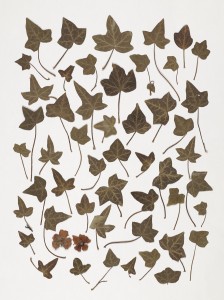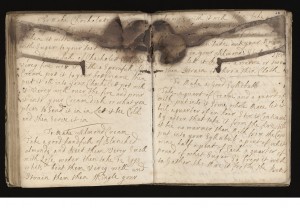By Lisa Smith, W&M Contributor

Cut foliage in Bridget Hyde’s book (c. 1676-1690): Wellcome MS 2990, image 150. Credit: Wellcome Library, London
A few days ago, a friend of mine mentioned on a certain social media site that she had just found pressed flowers in an eighteenth-century recipe book. Nothing unusual in that—there are lots of bits and bobs stuck into old papers.* But it is always a delight for researchers.
Here is my top five list of unexpected things that I’ve found:
- a doodle of a strange turtle man holding an envelope, at the bottom of an eighteenth-century love letter (Wellcome Library).
- two crumbling blue pills in a small packet attached to an early nineteenth-century collection of family medical letters and recipes (Dordogne Archives).
- several recipe clippings, with hand-written notes, stuck into an early twentieth-century cookery book that I found at an Oxfam shop.
- a burn mark that goes through half of a seventeenth-century recipe book (Wellcome Library).
- the scent of tea leaves wafting through a series of eighteenth-century medical consultation letters (British Library).
We might handle old texts and piece together stories all the time, but somehow such surprises tease us with the sense that we’ve directly encountered the past. The burn mark evokes a busy woman who had been cooking while keeping the book a little too close to the hearth where a stray cinder landed upon it. Or perhaps, she was scratching away in the book by candlelight and accidentally knocked the candle over onto the open book… We can imagine the woman’s consternation as she beat out the fire on her book.

Epicentre of the burn in Wellcome MS 4051. (Thanks to archivist Helen Wakely who told me about this book!) Credit: Wellcome Library, London.
Our fragmentary link to the past, however, is not straightforward. As my friend pointed out, the biggest mystery is what century the flowers are from. Just as there is no evidence to indicate who pressed the flowers, or when, the true circumstances of the recipe book damage will never be determined. The blue pills don’t correspond to any specific references in the family’s papers. The recipe clippings are undated and the tea-scented letters might have been put in a chest over a hundred years later. The only definitive evidence for my list is that the turtle man doodle was in the same ink as the rest of letter.
These moments of archival wonder may not offer much in the way of facts, but they are nonetheless important. They remind us that the manuscripts had users other than us: people who read the books, failed to take their pills and stored letters in safe places.
And they give us an excuse to let our historical imaginations run rampant before we get back to business…
Have you found any surprises in the archives?
* The medievalfragments blog , for example, frequently discusses textual curiosities in medieval manuscripts. My favourite post is on “Paws, Pee and Mice: Cats among Medieval Manuscripts”.
Lisa Smith is an Associate Professor of History at the University of Saskatchewan. She writes on gender, family, and health care in England and France (ca. 1600-1800) and blogs at Sloane Letters Blog and The Recipes Project. She tweets as @historybeagle.
